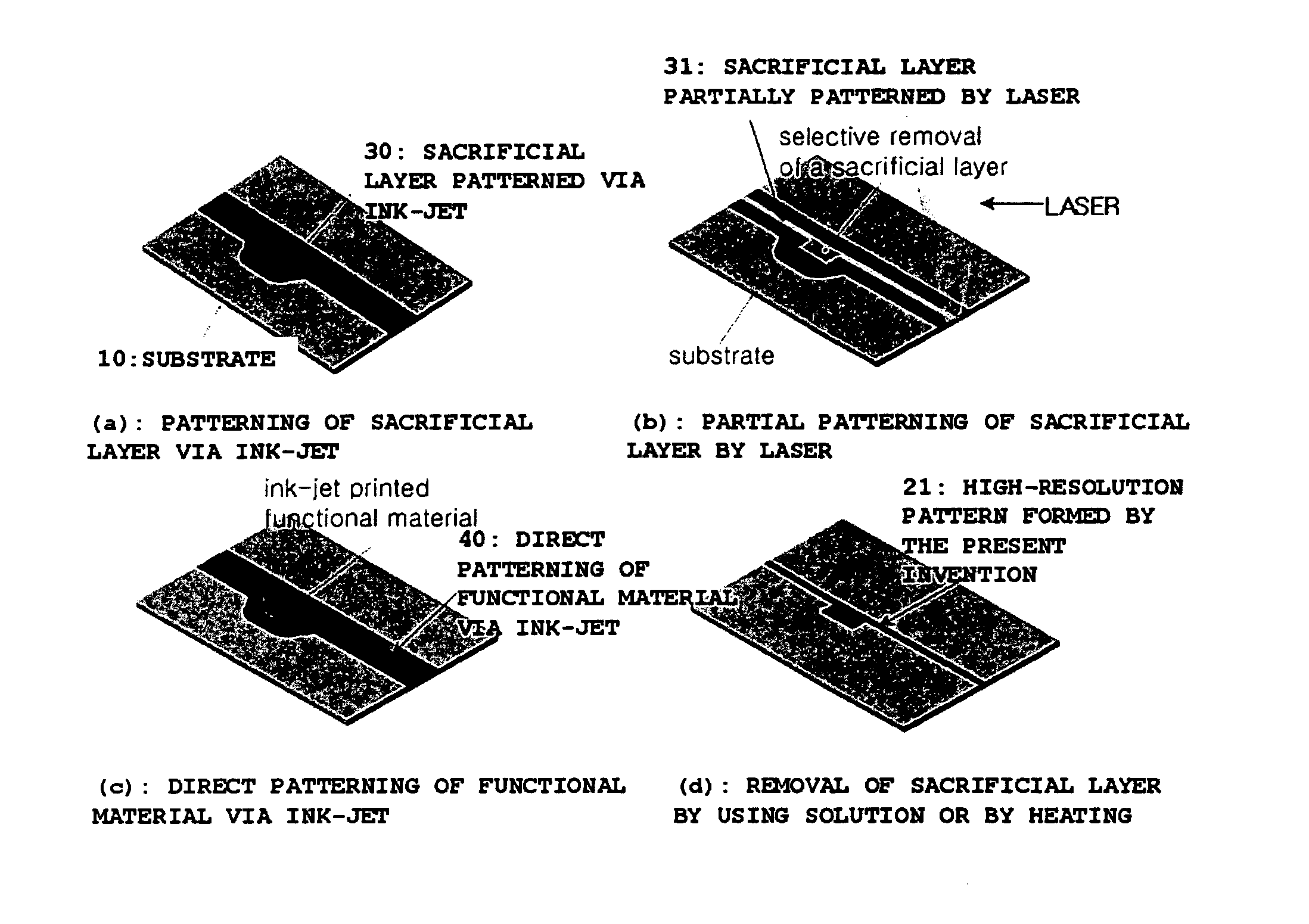Method for forming high-resolution pattern with direct writing means
a high-resolution pattern and direct writing technology, applied in the field of high-resolution pattern and substrate, can solve the problems of wasteful photolithography, poor applicability of a new design of photolithography to actual production lines, poor processing efficiency, etc., and achieve low waste of high-cost functional materials. , the effect of high processing efficiency
- Summary
- Abstract
- Description
- Claims
- Application Information
AI Technical Summary
Benefits of technology
Problems solved by technology
Method used
Image
Examples
example 1
[0100] In this example, a non-polar material was used as functional material ink containing no particles dispersed therein, and a polar material was used as a sacrificial layer material to provide little or no solubility between the functional material and the sacrificial layer.
[0101] First, to provide a composition for forming a sacrificial layer, 1.5 g of polyvinylalcohol (weight average molecular weight: 7,200, Fluka, 81368) and 0.5 g of a UV absorbing agent (black dye, LC Chem.) were dissolved in 15 g of water, 1 g of ethyleneglycol, and 0.5 g of glycerol to form ink for ink-jet. Next, the ink is applied onto a glass substrate by using an ink-jet device (JetLab, MicroFab) to form the pattern of a sacrificial layer with a width of 600 μm. Then, the pattern of the sacrificial layer was partially removed by UV laser (355 nm, Avia 2000, Coherent Inc.) with a beam diameter of 30 μm to form regions to be patterned subsequently by a functional layer. The laser was operated under the c...
example 2
[0102] In this example, a polar material was used as functional material ink containing particles dispersed therein, and a non-polar material was used as a sacrificial layer material to provide little or no solubility between the functional material and the sacrificial layer.
[0103] First, to provide a composition for forming a sacrificial layer, 5 g of PMMA (weight average molecular weight: 50,000, Fluka, CAS No. 9011-14-7) and 1.5 g of a UV absorbing agent (black dye, LC Chem.) were dissolved in 1,2-Dichloroethane(Molecular weight: 98.96, CAS No. 107-06-2) to form ink for ink-jet. Next, the ink is applied onto a glass substrate by using an ink-jet device (JetLab, MicroFab) to form the pattern of a sacrificial layer with a width of 500 μm. Then, the pattern of the sacrificial layer was partially removed by UV laser (355 nm, Avia 2000, Coherent Inc.) with a beam diameter of 30 μM to form regions to be patterned subsequently by a functional layer. The laser was operated under the con...
PUM
 Login to View More
Login to View More Abstract
Description
Claims
Application Information
 Login to View More
Login to View More - R&D
- Intellectual Property
- Life Sciences
- Materials
- Tech Scout
- Unparalleled Data Quality
- Higher Quality Content
- 60% Fewer Hallucinations
Browse by: Latest US Patents, China's latest patents, Technical Efficacy Thesaurus, Application Domain, Technology Topic, Popular Technical Reports.
© 2025 PatSnap. All rights reserved.Legal|Privacy policy|Modern Slavery Act Transparency Statement|Sitemap|About US| Contact US: help@patsnap.com



